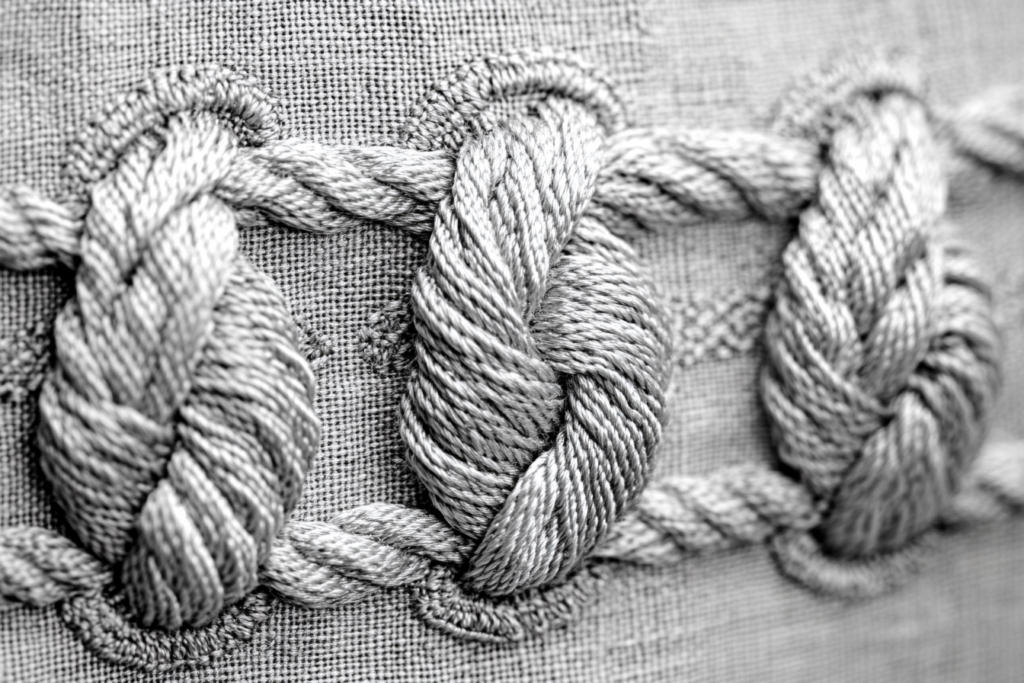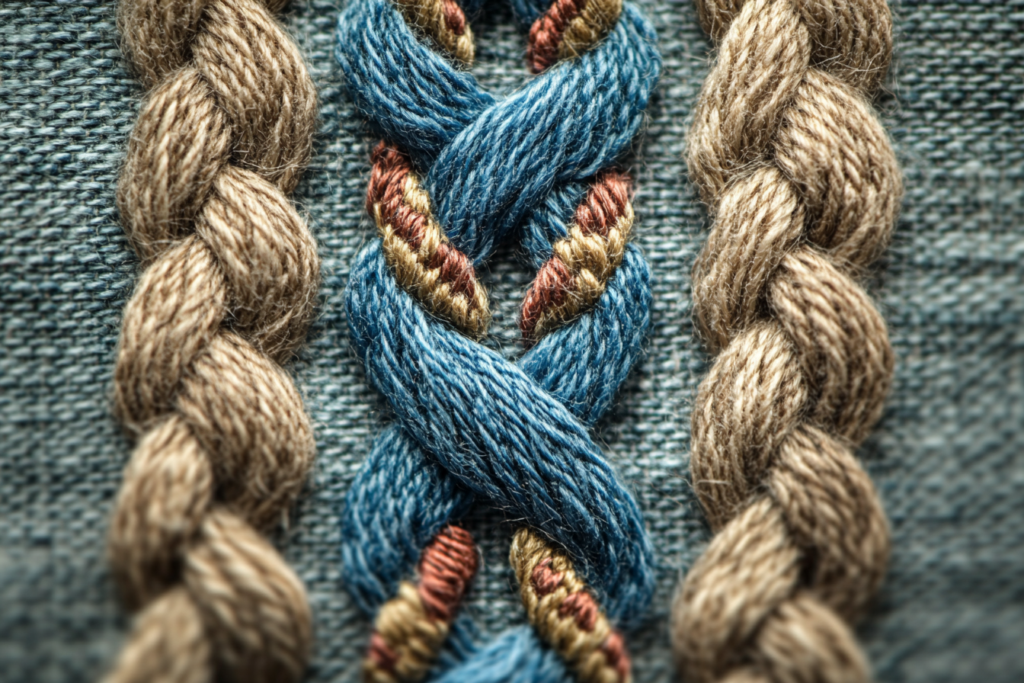Introduction: What is Cable Stitch in Embroidery?
The cable stitch is a beautiful and intricate type of embroidery stitch that is used to create a textured, rope-like effect on fabric. This stitch is favored by crafters and designers for its ability to add depth, structure, and visual interest to various textile projects. The cable stitch is particularly popular in hand embroidery, where its complex yet striking appearance can enhance the overall look of the design.
In this article, we’ll explore what the cable stitch is, how it’s created, and the various ways it can be incorporated into embroidery projects for stunning results.


How Does the Cable Stitch Work?
The cable stitch is a type of embroidery stitch that mimics the look of twisted or braided cables. It is typically formed by creating a series of loops or twists that are carefully woven into the fabric. Here’s how the stitch is created:
- Starting Point:
- To begin, the needle is inserted at the starting point of the cable stitch. This could be at the end of a design or where you want the texture to start.
- Forming the First Loop:
- The stitcher forms a loop by passing the needle through the fabric, bringing it back to the surface, and then pulling the thread to create a slight twist.
- Creating the Twist:
- As you continue, the needle is worked through the loop several times, twisting the thread in a way that creates a “rope-like” texture. This process is repeated for each loop, which is stacked or aligned next to each other.
- Finishing the Stitch:
- Once the cable stitch is completed, the thread is anchored securely in place, and the looped texture is visible, resembling a twisted cable. This stitch can be as thick or thin as the crafter prefers, depending on the number of twists and the thickness of the thread used.
Why is the Cable Stitch Important in Embroidery?
The cable stitch is important in embroidery because it adds texture and dimension to otherwise flat designs. Here’s why it’s so valuable in textile arts:
- Adds Depth and Texture:
- The cable stitch is one of the best ways to add a three-dimensional effect to an embroidery project. The twisted, rope-like design stands out from the fabric and adds depth to flat embroidery patterns.
- Versatility:
- This stitch can be used to create a variety of effects, from thick, bold cables to more delicate, fine threads. It is versatile and can be adapted to different types of embroidery projects, including decorative stitching on clothing, home décor items, and accessories.
- Visual Interest:
- Whether used as a border, filler, or accent, the cable stitch introduces intricate detail to the design. Its fluid, twisting nature contrasts beautifully with flat stitches like satin or straight stitches, making it a popular choice for creating balance and harmony in embroidery.
- Durability:
- The cable stitch is often used in projects that need to withstand some wear and tear. Because of its twisted structure, it can provide extra strength and stability to the fabric.
Applications of the Cable Stitch in Embroidery
The cable stitch can be used in a variety of ways to enhance embroidery projects. Here are some common applications:
- Borders and Edges:
- The cable stitch is often used to outline or frame designs. It creates a bold, textured border that can make a design stand out, giving it a finished, polished look.
- Floral and Nature Designs:
- This stitch is ideal for adding texture to floral or botanical embroidery. It can be used to represent stems, vines, or even the texture of flowers, giving the design a natural, lifelike appearance.
- Lettering and Monograms:
- The cable stitch is sometimes used for adding texture to embroidered lettering or monograms. The rope-like effect gives the text a more prominent and eye-catching presence, perfect for personalized gifts or decorative pieces.
- Textured Backgrounds:
- In some embroidery projects, the cable stitch can be used as part of the background to provide texture and depth. It works well for creating contrasts and visual interest behind other, simpler stitches.
- Furniture and Upholstery:
- In addition to clothing and accessories, the cable stitch is sometimes used in upholstery work. It adds a durable, decorative element to furniture fabric and other textile-based home décor items.
Types of Cable Stitches
While the cable stitch is commonly used in hand embroidery, there are several variations that you can explore to add even more texture and dimension to your projects:
- Twisted Cable Stitch:
- This version of the cable stitch involves twisting the thread in a more pronounced way, creating a thicker, more defined rope effect.
- Split Cable Stitch:
- In this variation, the thread is split as it is twisted, allowing for a more textured look with a slightly more open design.
- Double Cable Stitch:
- The double cable stitch involves two twisted threads instead of one, creating a wider, more voluminous rope. This can be particularly striking when used for larger designs or when you want the cable to stand out even more.
- Diagonal Cable Stitch:
- A more dynamic variation of the basic cable stitch, this version is worked on an angle, giving it a more diagonal or spiral-like appearance. This is a great option for adding movement to a design.
How to Master the Cable Stitch
Mastering the cable stitch takes practice, but once you’ve perfected it, you’ll be able to use it in countless embroidery projects. Here are some tips to help you achieve the perfect cable stitch:
- Use the Right Thread:
- The thickness and texture of the thread play a significant role in how your cable stitch will look. Thicker threads create more pronounced cables, while finer threads offer a subtler, delicate effect.
- Practice Even Tension:
- Consistent tension is key to achieving a smooth, even cable stitch. Be sure to pull your thread tight enough to create a firm twist, but not so tight that it distorts the fabric.
- Work in Small Sections:
- To prevent the thread from tangling or becoming too loose, work in small sections at a time. This will give you better control over the stitch and allow you to perfect each loop as you go.
- Experiment with Angles:
- Don’t be afraid to experiment with different angles and shapes for the cable stitch. You can adjust the direction of the stitch to create different effects and textures.
Conclusion: The Versatility of the Cable Stitch in Embroidery
The cable stitch is an elegant and versatile embroidery technique that adds depth, texture, and a unique, rope-like effect to fabric. Whether used for borders, floral designs, or as part of a textured background, it can elevate the quality of any embroidery project. With practice, you can master the cable stitch and apply it to a wide variety of textile designs, from clothing and accessories to home décor.
By incorporating the cable stitch into your embroidery repertoire, you will be able to create visually striking and durable pieces that stand the test of time.



